Howard Andrew Jones's Blog, page 30
August 1, 2016
The Long Ships
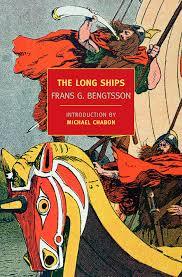 Here’s another grand adventure novel that any lover of such really ought to read, or keep on the shelf to read again. My own copy’s so frayed I’ll probably pick up another, because it’s one I intend to revisit.
Here’s another grand adventure novel that any lover of such really ought to read, or keep on the shelf to read again. My own copy’s so frayed I’ll probably pick up another, because it’s one I intend to revisit.
You can find a lot of praise about just how fine The Long Ships is, and I could throw in my own weight and say, yeah, it’s a great adventure novel and thereafter provide detail, but I have books to write and a house to clean, and besides, here’s Michael Chabon. Check out what he has to say.
A movie was made in 1964 based upon the first third of the book, starring Sydney Poitier and Richard Widmark. I seem to recall it was both pretty good and fairly faithful. The book, though, is where you ought to go first.
July 29, 2016
Character Design, Part 3: Character Voice
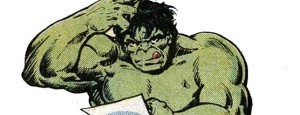 The other day my friend Mick swung by the site and asked if I had any advice about character design. Specifically, he was curious about how I: “find a character’s voice to begin with? Just feel it out? Or focused, prescribed exercises?”
The other day my friend Mick swung by the site and asked if I had any advice about character design. Specifically, he was curious about how I: “find a character’s voice to begin with? Just feel it out? Or focused, prescribed exercises?”
I’ve offered advice about character creation before (here, where I discuss character design, here, where I added an addendum, and here, where I talk about loving your character.) But looking over all of that I see that I’ve never really discussed how I find a character voice. Everything I’ve written about is advice to use AFTER that point.
So I gave the matter some thought. I’m not sure how other writers do it, or what works for them, but I can tell you what works for me.
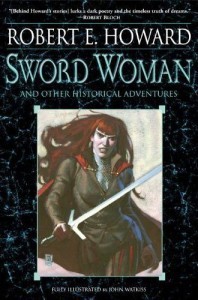 A lot of my characters are based from figures from books or movies or historical figures whom I respect or admire. (I almost always start with heroes and then design enemies to oppose them.)
A lot of my characters are based from figures from books or movies or historical figures whom I respect or admire. (I almost always start with heroes and then design enemies to oppose them.)
I’ve written that I could hear Asim’s voice, from my historical fantasy series, very clearly. Well, that’s because I’d been reading a slew of Harold Lamb stories for years, but most likely because I’d just re-read Robert E. Howard’s historical story, one of my very favorites by him, “The Road of Azrael” (found most easily these days in the Del Rey anthology Sword Woman).
Asim began as a riff off of Robert E. Howard’s wonderful narrator to that particular story. He ended up becoming different, but that was the starting point. And you could say that Dabir is a kindler, gentler, not as infallible version of Sherlock Holmes through an Arabian lens. (Basically I removed the parts about Sherlock Holmes that had always irritated me a bit and made Asim much more of a partner than Watson ever was.)
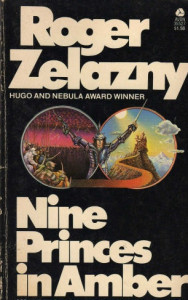 My current work is hugely influenced by my all-time favorite fantasy series, Roger Zelazny’s original Chronicles of Amber. I always loved the characters of Corwin and Benedict, the first being the flawed, dark hero of the series and the second his older brother, the noble, haunted, genius strategist and tactician. Well, two of the characters in the series-in-progress began as riffs on them, but shifted though my own lens, first because I don’t want to write pastiche, second because I can’t write like Roger Zelazny, third because I have a different tale to tell. (There are probably fourth and fifths to boot.)
My current work is hugely influenced by my all-time favorite fantasy series, Roger Zelazny’s original Chronicles of Amber. I always loved the characters of Corwin and Benedict, the first being the flawed, dark hero of the series and the second his older brother, the noble, haunted, genius strategist and tactician. Well, two of the characters in the series-in-progress began as riffs on them, but shifted though my own lens, first because I don’t want to write pastiche, second because I can’t write like Roger Zelazny, third because I have a different tale to tell. (There are probably fourth and fifths to boot.)
In my series-in-progress, the character who started out being Corwinesque still has some of Corwin’s madness and selfishness, his appetites and instinct for self-destructive acts, but coming as he does from a more supportive background, he’s kinder and more dedicated to others. My take on Benedict is less removed from the people around him and far more involved in the story (as a matter of fact, he’s become my wife’s favorite character in the first book). I think most fans of Amber wanted to see much more of Benedict, so the guy who started out as a shadow of him in my own tale gets a lot more screen time.
Another character in said book is loosely based on what I’d imagine James Bond as portrayed by young Sean Connery would have been like as he launched his career.
In short, then, I start with characters who interest me from other places, twist them around a little so they become mine, and throw them together despite disparate origins. Just tossing in characters inspired from different sources changes things up right away.
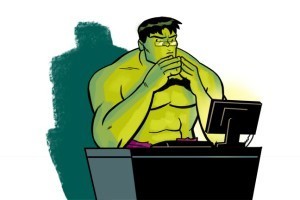 Once I have THOSE people I can start creating other characters who bounce off of them. A lot of them are no longer riffs — it’s almost as though once I have a few notes going it’s easier to improvise, if that makes sense. For instance, the central protagonist, a woman named Elenai, isn’t based on anyone in particular, although she certainly has some characteristics in common with my wife and other heroic women. As I’ve mentioned in the third essay linked above, I actually had trouble finding her voice, because I incorrectly wrote her as too young and inexperienced. When I recast her with greater intelligence right from the get-go, someone just on the cusp of greatness, she, and the story, really began to gel.
Once I have THOSE people I can start creating other characters who bounce off of them. A lot of them are no longer riffs — it’s almost as though once I have a few notes going it’s easier to improvise, if that makes sense. For instance, the central protagonist, a woman named Elenai, isn’t based on anyone in particular, although she certainly has some characteristics in common with my wife and other heroic women. As I’ve mentioned in the third essay linked above, I actually had trouble finding her voice, because I incorrectly wrote her as too young and inexperienced. When I recast her with greater intelligence right from the get-go, someone just on the cusp of greatness, she, and the story, really began to gel.
Mick, I hope that helps, and I hope this essay will be helpful to other writers as well. Please, if anyone else has writing craft questions, don’t hesitate to drop me a note. And believe me, I’m still figuring this out as I go, so if anyone has useful advice, we’d all love to hear it
July 27, 2016
B-17 Leader
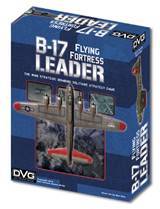 From time to time I talk about solitaire gaming here on the blog, as any frequent visitors know, and recently I mentioned I’ve been testing a game.
From time to time I talk about solitaire gaming here on the blog, as any frequent visitors know, and recently I mentioned I’ve been testing a game.
Yesterday evening that game went live on Kickstarter, and I sat down with both that game’s designer and the company’s owner, the award winning game designer Dan Verssen, to chat about both B-17 Leader and gaming in general. You can find my interview with Dean Brown over at Black Gate, and you can find the newly launched B-17 Kickstarter here.
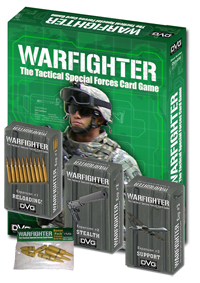 Dan, tell us a little bit about yourself and your background. Have you always been a board gamer?
Dan, tell us a little bit about yourself and your background. Have you always been a board gamer?
I started playing wargames in high school. That was back in the early ’80s. At the time we were playing Advanced Dungeons & Dragons, many of the games from Avalon Hill, West End Games, Traveller, and all of Steve Jackson’s pocket games. I got together with friends multiple times a week to play the newest game. Needless to say, gaming has always been my passion and hobby. My wife Holly empowered and encouraged me to pursue my passion to create games by suggesting that we start our own game company.
Our idea was to make games based on all the knowledge we had accumulated. I’m thankful for years of experience around this industry doing design, development, art, and production work. This resulted in the game mechanics within our games not only being unique in their ability to be fun and challenging, but also inspiring friends and families to play together. They could then share more quality time, and compete against each other, or against the system. Our son Kevin is a great help at DVG, and it has been a valuable experience to share with him as we get to work together as a family to build our futures.
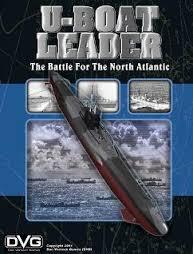 How did you get involved in game design?
How did you get involved in game design?
Around the same time I started playing, I began designing my own games and sharing my ideas with friends. I’m still grateful to all of them for playtesting my games and providing helpful feedback so I could improve. Hours spent as an adolescent cutting out my own counters and recreating games became the foundation for the company my family and I are building. Brainstorming with my wife, actually assembling prototypes, finally sending out the completed games, and all the chaos in-between is what keeps me inspired as I find each day an opportunity for adventure and growth.
How long have you been in business?
We started DVG in 2008, and since then we’ve published dozens of games. Recently we began turning to Kickstarter to help with funding. We’re still a small family business, and printers need to be paid up front. This leads to a major cash flow problem that’s difficult for most businesses to overcome. Fortunately, we’ve received amazing support from the people on Kickstarter, and we’ve been able to produce games which have much higher quality pieces than we ever would have thought possible. Our deepest thanks goes out to all the people who have supported our games!
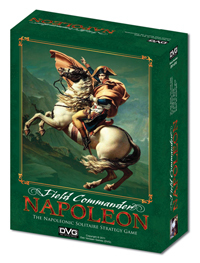 What interested you in tactical and solitaire games?
What interested you in tactical and solitaire games?
When I started the company, gaming was less popular, so I transitioned into building solitaire games. This allowed for me to combine a multiplayer system with solitaire rules and create games that could transition between themes and yet remain entertaining and fun.
This process has been the basis for our Warfighter, Air Leader, and Field Commander series of games. These games are either solitaire, or designed for 1 or more players. In all cases, the games do not require special rules when playing solo.
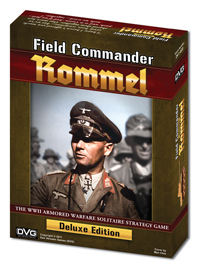 Have you always been interested in World War II?
Have you always been interested in World War II?
Yes, every since I was young it was really fascinating for me to learn more about the dynamics of the time, as well as the weapons, tactics, and different restrictions that were apparent throughout the war.
WWII has so much depth that it allows for endless gaming possibilities: tactical games, operational games, and strategic games covering every front, campaign, and operation.
For example, in our Field Commander: Rommel game, you command divisions of troops in France and North Africa. In our Fleet Commander: Nimitz game, you command the US Navy in the Pacific from 1942 to 1945. In our new Warfighter WWII series, you command individual soldiers.
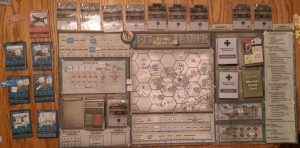
B-17 Leader prototype board.
There are other games about flying bombers in the war. How is yours different?
Dean Brown contacted us with his ideas for a solitaire WWII bomber game that would fit into our Air Leader series. He’s done an amazing job of creating a unique design that captures the feel of those desperate days of flying missions deep into enemy territory while battling German fighters.
Our game is unique in that it puts the player in the position of decision making on both the strategic and tactical levels. You don’t just get to allocate your bomber and fighter groups to the weekly targets, you then get to tactically resolve each mission. You play out each fighter attack on your bombers, and see how well your escorts and gunners drive them off.
B-17 Flying Fortress Leader also generates decisions for the German air defenses based on which Air Defense Commander they have in play. Each commander has his own style of allocating German fighter squadrons, resources for new technologies, and allocating fighters to the European, Mediterranean, and Russian theaters.
I think our game strikes a great balance between detail and abstraction. When playing, you get to make decisions that really matter, while at the same time not getting bogged down in a ton of procedures and complexity.
For more information about both solitaire and multiplayer games from DVG, visit their web site.
For other talks on my site about gaming, click here.
July 25, 2016
Gray Maiden
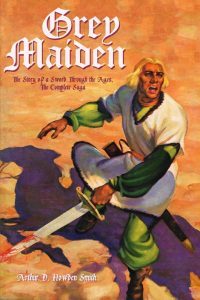 I had a longer post in mind, but I need to get to some yard work before it heats back up today. So here’s a great old short story series that any heroic fiction appreciator ought to snag.
I had a longer post in mind, but I need to get to some yard work before it heats back up today. So here’s a great old short story series that any heroic fiction appreciator ought to snag.
I remember when it was only possible to get some of the Gray Maiden stories. Now you can snag them all in a single book.
Gray Maiden is a series of short stories originally published in that great old pulp, Adventure, about a sword that’s handed down through the ages. There are minor notes of the supernatural in most of the stories (very minor, but still notable given Adventure being reality based) but what’s most appealing is just the slam bang action of the tales.
I’ve written about Gray Maiden before (and Black Gate‘s Matthew David Surridge has written about one earlier collection here). Some of the stories are pulpy, some are dry, but at least half are top notch action pieces. The one set in Viking times, for instance, is one of the best Viking stories I’ve ever read, and then there’s the one about the Carthaginians trapped behind in Italy after Hannibal evacuates, and their desperate effort to escape…
The only thing in common with each of the stories is that grand, terrible old sword, Gray Maiden. It’s whispered that no one who wields it can be defeated in combat with a sword, and the blade itself is impossibly sharp.
Anyway, you should get the book and read the stories. You can buy it here in various formats, and of course through the usual channels.
I like the concept behind these stories so much I actually wrote my own Gray Maiden story, featuring an Arabian hero who gets his hand on the sword. I haven’t written “fan fic” since junior high, when I was writing my own Star Trek stories. I suppose I should try to get that Gray Maiden story published some time…
Oh, and incidentally, that book cover is from an issue of Adventure that featured one of the all-time best Harold Lamb stories: that’s probably Nial O’Gordon right there, who would have been his most famous character if he’d written more than two stories about him. Lamb, by then, was successfully writing history books and writing for the better paying “slick” magazines, so only two Nial O’Gordon stories ever saw print. So far as we know, he didn’t compose any others. A pity. (You can find them both in Swords from the West.)
July 22, 2016
Point of View Arcs
 After my first three published novels I’ve begun to play more and more with multiple point of view. I still miss writing from the restricted first person narrative of the Dabir and Asim novels (and I still hope to write some more of those) but I’m getting more and more used to writing with multiple third person point of view.
After my first three published novels I’ve begun to play more and more with multiple point of view. I still miss writing from the restricted first person narrative of the Dabir and Asim novels (and I still hope to write some more of those) but I’m getting more and more used to writing with multiple third person point of view.
I played a little with it in my first Pathfinder novel, then experimented even further with the second, switching point of view every chapter, being careful to give each character something interesting to do as the camera changed to their perception at the same time the plot advanced. Because the characters were all together rather than split off on separate quests, it was necessary to write the events chronologically.
With these new books, though, that hasn’t been necessary (I’ll be talking more about them in months to come). With the first one, I didn’t start serious work on the secondary character arc until I was on the second draft of the main arc, which was honestly a little bit of an accident. It happened to work so well, though, that as I drafted the second book of this new series I wrote all of one arc, then all of the next arc, then all of the third, then all of the much shorter fourth.
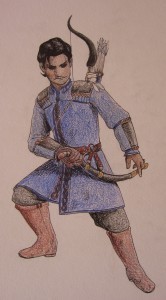
Copyright Darian Jones
Now, as I revise this second book of the new series, I’m experimenting with sticking with the same process, even though it means writing things out of order. I’m leapfrogging over important events that are taking place in a second character’s arc and jumping to events taking place days later so I can keep working in the first character’s point of view. When I’m done with him, I’ll start work revising her arc. Why? Well, I find one of my struggles is to find each character’s voice. It can be challenging sometimes to slide “into their head” if I’ve been away for a while. It can sometimes cost me hours or even days to get it back. Obviously, if I’m constantly switching back and forth during composition and revision it causes more lost time than if I only make the transition once with each character.
If I stay with that one character I don’t have to remind myself who they are or what their agenda is, and I can keep on making progress. Right now, this seems to be working.
There are dangers, of course. One is that I’ll neglect to keep something in mind that’s happening elsewhere, or that when I write some other point of view that I’ll come up with something that will later impact the sections I’m working on and have to make changes. But I’m currently focused on polishing the rough first draft into a readable second draft — third draft I’ll be revising it straight through and hopefully providing the final polish. At that point I can address any changes to arcs that come about because of events in other sections.
Will this process work in the long run? I can’t know for sure, but it’s a tactic that seems to be working for this writer at the present, and that’s the important thing. I’d like to think that I’m getting better at this whole writing thing, and I offer the procedure to you in the hope you might find it useful.
July 20, 2016
48
 Owning to his presence at an out-of-town summer camp the last few years during the week of my birthday, my son hasn’t been around to celebrate with me on that one day for a long while. He was here this time, though, and, marred only by the absence of my daughter at a summer camp of her own, this 48th birthday has been my favorite in recent memory.
Owning to his presence at an out-of-town summer camp the last few years during the week of my birthday, my son hasn’t been around to celebrate with me on that one day for a long while. He was here this time, though, and, marred only by the absence of my daughter at a summer camp of her own, this 48th birthday has been my favorite in recent memory.
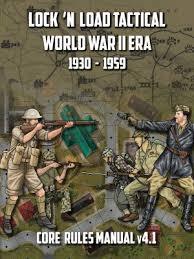 I woke up after having dreamed I was a Beatle hanging out with Paul and John and some other Beatle named Phil at some time in ’65, judging by our hair, answering press questions and being fab together. That was pretty gear.
I woke up after having dreamed I was a Beatle hanging out with Paul and John and some other Beatle named Phil at some time in ’65, judging by our hair, answering press questions and being fab together. That was pretty gear.
I wrote until about noon, then did some calisthenics with the first born, had lunch with him, then played a couple of war board games of Lock ‘n Load Tactical: Heroes of Normandy. Following on that, we traded off playing piano and guitar and hashed out a couple of songs together.
By then it was supper time, so we drove downtown and met my wife for a swank dinner (I had duck!). Upon our return home the first born dialed up a college friend via Skype then ran a science role-playing game for her, my wife, and me.
A grand time was had by all. I got to write, game, eat great food, play music, and hang out with (most) of my immediate family. It doesn’t get much better.
July 18, 2016
Elkins Again or At Last
 As I was logging on to the interwebs this morning I received four notifications of new posts on the ‘ol web site. Traffic here hasn’t been as heavy lately — probably because I haven’t been on the site as often — so I was pleased. Except that all the posts were from trendily mis-spelled names, replies to old posts, and each was a single line of word salad encouragement rife with typos.
As I was logging on to the interwebs this morning I received four notifications of new posts on the ‘ol web site. Traffic here hasn’t been as heavy lately — probably because I haven’t been on the site as often — so I was pleased. Except that all the posts were from trendily mis-spelled names, replies to old posts, and each was a single line of word salad encouragement rife with typos.
In short, it was spam, all from an IP in St. Petersburg. I still am awaiting some kind of explanation about how that nonsense helps anyone. Do these people get PAID to create spam? They must. And what does anyone get out of it? The mind boggles.
Right. So here’s what I MEANT to say today. Two interesting things are happening that have nothing to do with any of the problems and dilemmas we’re currently riding out in our republic.
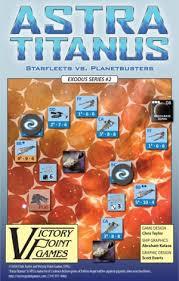 First, Victory Point Games has little more than a day left in its 10% sale (and you’ll get an additional 10 % off if you buy more than $100.00 worth of games). I happen to like a lot of the VPG games, and have written about them through the years. I was particularly inspired to point out the sale today because they may soon cease publication of their print-on-demand style games. Like, say Astra Titanus, which is one of my favorites. Anyway, go check it out.
First, Victory Point Games has little more than a day left in its 10% sale (and you’ll get an additional 10 % off if you buy more than $100.00 worth of games). I happen to like a lot of the VPG games, and have written about them through the years. I was particularly inspired to point out the sale today because they may soon cease publication of their print-on-demand style games. Like, say Astra Titanus, which is one of my favorites. Anyway, go check it out.
Second, Breckinridge Elkins is finally in print again. And this time it looks like ALL of his tales are going to be collected properly. There will be two volumes, and not only will readers be able to see the novel and the separate short stories that make it up (there are additions and subtractions in detail in content) but the two-book set will include all the rest of Howard’s tall tales.
Wait, you say, what is it I’m talking about? Well, late in his young life Robert E. Howard had a long-running character of mythic proportions who told amazing whoppers about himself and his family of country folk.
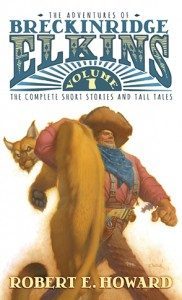 Much as I love Robert E. Howard’s work, I was pretty late coming to Elkins. I mean, first, it’s a western. Second, it’s not fantasy. Third, it’s humorous. A lot of writing that’s allegedly humorous isn’t, really, it’s just painful. You probably know what I mean. Well, the Elkins stories are pretty funny. Even to me, who’s hard to please when it comes to comic writing. Not that I’m knee slapping all the way through every one of them, but I’m definitely at least grinning wryly. If you take them on their own terms, they’re a blast, and I’m going to be signing up for both books now in the next couple of days. Go take a look yourself!
Much as I love Robert E. Howard’s work, I was pretty late coming to Elkins. I mean, first, it’s a western. Second, it’s not fantasy. Third, it’s humorous. A lot of writing that’s allegedly humorous isn’t, really, it’s just painful. You probably know what I mean. Well, the Elkins stories are pretty funny. Even to me, who’s hard to please when it comes to comic writing. Not that I’m knee slapping all the way through every one of them, but I’m definitely at least grinning wryly. If you take them on their own terms, they’re a blast, and I’m going to be signing up for both books now in the next couple of days. Go take a look yourself!
July 15, 2016
Ki-Gor Volume 3
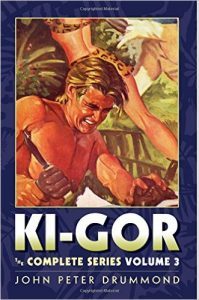 Just saw that the third volume of Ki-Gor stories from Altus Press is coming out. And guess who wrote the intro? Yep. You’re reading his blog.
Just saw that the third volume of Ki-Gor stories from Altus Press is coming out. And guess who wrote the intro? Yep. You’re reading his blog.
Who’s Ki-gor? Funny you should ask. Here’s a link.
July 14, 2016
Still Missing
 The wife has been complaining for a while now that I NEVER clear out my phone mails. She, being organized, comments upon it every time she has to borrow my phone.
The wife has been complaining for a while now that I NEVER clear out my phone mails. She, being organized, comments upon it every time she has to borrow my phone.
I figured she was probably right, because there were a lot of messages by this point, so I sat down for about 45 minutes yesterday and slowly got rid of everything. And a funny thing happened. As I worked my way back in time I started realizing that there could be a message from my friend Kris there. It probably wouldn’t be anything more than “hey, sorry I missed you, call me.” But at least I’d hear his voice, something that can’t ever happen again. I don’t think I have any videos of us together.
But there was nothing. A whole lot of messages and appointments I’d long since listened to or attended, but nothing from Kris. He’s been gone for about a year now, and I suppose I should be used to the fact. But not yet. Maybe never.
July 13, 2016
Book News
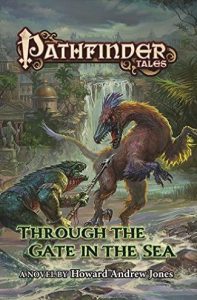 With the first novel of my new series now in my editor’s hands, I started to work revising my rough draft of book 2 — only to get a brainstorm last week about how to address some lingering concerns I had.
With the first novel of my new series now in my editor’s hands, I started to work revising my rough draft of book 2 — only to get a brainstorm last week about how to address some lingering concerns I had.
I figured out how to fix up the smallest point of view arc, consisting of three chapters, to make them far more compelling, and then made the adjustments to the next to last chapter necessitated by changes to those three. And now I’m feeling more confident about the work in progress than I have in any book since The Bones of the Old Ones.
Don’t get me wrong — I’m proud of both Beyond the Pool of Stars and its upcoming sequel Through the Gate in the Sea, and remain disappointed that the first one didn’t attract much attention. (I expected that, given that it was a tie-in, but I’m still disappointed.) This one, however, which is looking more and more like it will be titled For the Killing of Kings, is probably the best thing I’ve written, a judgment I would personally have reserved, until now, for Bones. It has a lot of moving parts and I think that they’re all churning along nicely. I can hardly wait for it to come out.
In the mean time, here’s the first time I’ve posted a cover of the sequel to Beyond the Pool of Stars. I’ll have to check with Paizo to get the name of the artist. Though the Gate in the Sea is slated for February 2017 release.
Howard Andrew Jones's Blog
- Howard Andrew Jones's profile
- 368 followers



